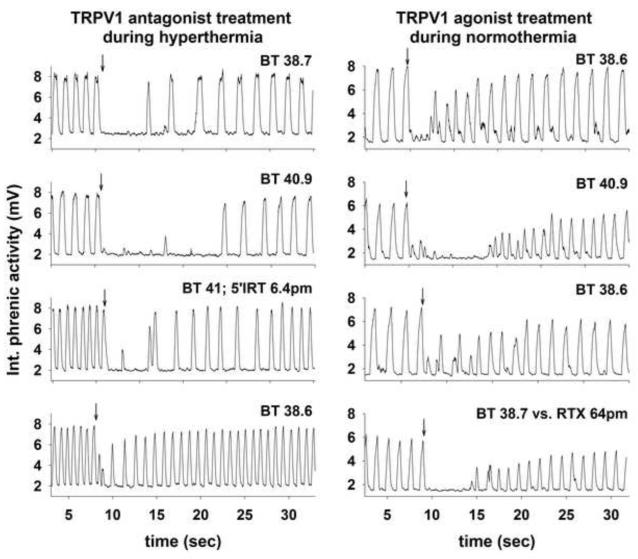Figure 1.
In the left set of tracings, integrated phrenic activity is shown during four tests of the LCR in a male piglet (post-natal age 6 days). The control response to laryngeal injection of 0.1 ml of water (at the downward arrow) at a normal body temperature is shown in the top panel. Elevating the body temperature (second panel) prolonged the duration of the LCR. The hyperthermic prolongation of the apnea and LCR duration was blocked after bilateral 100 nL microinjections of 6.5 μM 5′-idodresiniferatoxin into the caudal NTS (third panel). The LCR response during a final normothermic trial after the 5′-idodresiniferatoxin treatment (fourth panel) was quite short ‘BT’ indicates body temperature. The locations of the injections in this animal are marked by an asterisk in the schematic anatomical drawings in Fig. 2.
In the right set of records, integrated phrenic activity is shown during four tests of the LCR in a male piglet (post-natal age 5 days). The control response to laryngeal injection of 0.1 ml of water (at the downward arrow) at a normal body temperature is shown in the top panel. Elevating the body temperature (second panel) prolonged the duration of the LCR. The hyperthermic prolongation of the apnea and LCR duration was reversed when the animal was cooled back to normal body temperature (third panel). The LCR response during a final normothermic trial after bilateral 100 nL microinjections of 65 mM resiniferatoxin into the caudal NTS (fourth panel) was prolonged even though the animal was normothermic. The locations of the injections in this animal are marked by an asterisk in the schematic anatomical drawings in Fig. 3.

